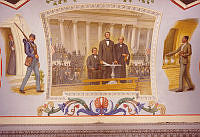Rubenstein Center Scholarship
NAACP and the White House
The Fight for Civil Rights
The Board of Directors of the National Association for the Advancement of Colored People (NAACP) met with President Lyndon B. Johnson at the White House on June 24, 1964. The forty-five minute meeting took place in the Cabinet Room of the West Wing.1 The meeting was off the record, so no official press coverage or documentation of the conversation exists. However, White House Counsel Lee White gave President Johnson a memo that outlined possible topics to discuss with the NAACP. These topics included: recognizing Roy Wilkins’ leadership, President Johnson’s response to three missing civil rights activists in Mississippi, how the NAACP could aid with compliance and cooperation with the new Civil Rights Act, and how to decrease dropout rates for African-American students.2 The last two topics specifically sought help and advice from the NAACP on issues that affected African-American communities across the country.
By 1964, the NAACP was a well-oiled machine that advocated for Black Americans and civil rights in the United States. Its leaders had been politically influential since the organization’s founding on February 12, 1909, promoting African-American rights to important political leaders, including American presidents.

Meeting with Roy Wilkins and NAACP Board of Directors and Vice Presidents
Lyndon B. Johnson Presidential Library and Museum/NARAThe NAACP formally began in response to the Springfield Race Riot. On August 14, 1908, an angry mob targeted Black homes and businesses in Springfield, Illinois after two Black men were accused of assaulting white women. The mob attempted to approach the accused men in jail, but after being turned away, they attacked innocent Black residents instead. The mob injured and killed residents, displacing roughly two thousand Black citizens. Law enforcement arrested roughly one hundred fifty participants but very few were convicted.3
In response to these events, a group of Black and White activists met in New York City in January 1909 with the goal of founding an organization to support the rights of African Americans. This meeting culminated into a call to action in the form of a letter, sent out to both White and Black Americans for a national conference on the centennial of President Abraham Lincoln’s birthday--February 12, 1909.4 Oswald Garrison Villard, a civil rights activist and future leader of the NAACP, authored the letter, signed by prominent activists including W. E. B. Du Bois, Mary Church Terrell, and Ida B. Wells-Barnett. It stated:
If Mr. Lincoln could revisit this country in the flesh he would be disheartened and discouraged. He would learn that on January 1, 1909, Georgia had rounded out a new confederacy by disfranchising the negro after the manner of all the other Southern states. He would learn that the Supreme Court of the United States, supposedly a bulwark of American liberation, had dodged every opportunity to pass squarely upon the disenfranchisement of millions, by laws avowedly discriminatory and openly enforced in such manner that the white men may vote and black men be without a vote in their government.5
Although state legislatures ratified the Fourteenth and Fifteenth Amendments in 1868 and 1870, respectively, state laws and a lack of federal protection still denied the rights promised to African Americans as United States’ citizens. In particular, Jim Crow laws and Black Codes allowed open discrimination, segregation, and disenfranchisement based solely on skin color.
Three hundred men and women answered the call by attending the first National Negro Conference held at Charity Organization Hall in New York City from May 31 to June 1, 1909.6 The conference established the National Negro Committee and adopted a platform proclaiming:

W. E. B. Du Bois, a prominent African-American activist and scholar
Library of CongressWe denounce the ever-growing oppression of our 10,000,000 colored fellow citizens as the greatest menace that threatens the country. Often plundered of their just share of the public funds, robbed of nearly all part in government, segregated by common carriers, some murdered with impunity, and all treated with open contempt by officials, they are held in some states in practical slavery to the white community.7
The committee went on to address the importance of education and skilled labor while emphasizing that nothing could change until the U.S. government recognized and protected the legal rights of African Americans. They ended with several demands for change. They called specifically upon the federal government, Congress, and the president to strictly enforce the rights guaranteed under the Fourteenth Amendment, to create equal experiences and opportunities in education for Black and White children, and to allow African Americans to vote like other United States citizens as guaranteed by the Fifteenth Amendment.8
During the second annual meeting on May 12, 1910, the National Negro Committee formally changed its name to the National Association for the Advancement of Colored People (NAACP).9 The newly-formed NAACP was prepared to defend and protect African-American communities through direct interaction and engagement with Congress and the president.
One of the earliest interactions with a sitting president occurred when the NAACP protested President Woodrow Wilson’s decision to allow segregation in the Treasury Department and the Post Office in 1913.10 Many African Americans did not believe that segregation aligned with President Wilson’s presidential campaign promises in 1912. In a letter to the NAACP’s Vice President Bishop Alexander Walters on October 16, 1912, President Wilson stated:
The colored people of the United States have made extraordinary progress towards self-support and usefulness, and ought to be encouraged in every possible and proper way. My sympathy with them is of long standing, and I want to assure them through you that should I become President of the United States they may count upon me for absolute fair dealing and for everything by which I could assist in advancing the interests of their race in the United States.11
President Wilson believed segregating the federal government was in the best interest of African Americans.12 In a letter to Oswald Garrison Villard, chairman of the Board of Directors of the NAACP, President Wilson stated, “By putting certain bureaus and sections of the service in the charge of negroes we are rendering them more safe in their possession of office and less likely to be discriminated against.”13
The NAACP captured the dissatisfaction with this decision in an open letter to President Wilson on August 15, 1913, using Wilson’s own words and policies against him:
Shall ten millions of our citizens say that their civic liberties and rights are not safe in your hands? To ask the question is to answer it. They desire a “New Freedom,” too, Mr. President, yet they include in that term nothing else than the rights guaranteed them by the Constitution under which they believe they should be protected from persecution based upon a physical quality with which Divine Providence has endowed them.14
Even in its infancy, the NAACP served as a political and civil leader for African Americans, but President Wilson did not change his stance on the matter. Segregation was a politically charged topic throughout the United States in the twentieth century and the federal workforce remained segregated for three decades.
Although the NAACP’s fight against segregation came to a halt with President Wilson, the organization mobilized against other infringements on the rights of African Americans across the country. They argued and won a number of legal cases such as Guinn v. United States (1915) and Buchanan v. Warley (1917).15 In 1916, the NAACP also created an Anti-Lynching Committee to raise awareness about the unlawful murders of African-American citizens. The NAACP grew immensely over subsequent decades to address as many social and civil injustices as possible. The organization had a few interactions with presidents and a notable one with President Calvin Coolidge. In response to police brutality on August 23, 1917, the Black 24th Infantry regiment rioted in Houston, Texas. Eighty one men were placed in jail. On February 7, 1924, the NAACP met with President Coolidge to pardon those who remained in jail. President Coolidge reduced everyone’s sentence and released twenty men.16 This marked the small beginning of a cooperative relationship between the NAACP and presidents which bloomed during President Harry S. Truman’s administration.
Due to the organization’s prominence and national outreach, the NAACP played a role in the desegregation of the federal workforce by President Truman. During his administration, President Truman was advised by the NAACP on civil rights. On December 5, 1946, Truman signed Executive Order 9808 at the White House, which established the President’s Committee on Civil Rights, intended “to strengthen and safeguard the rights of the American people.”17 Sadie T. Alexander and Channing H. Tobias were the only African Americans out of the committee’s sixteen members. Alexander, the first African-American woman to practice law in the state of Pennsylvania, was an active leader of the NAACP’s Philadelphia branch.18 Tobias was a member of the Board of Trustees of the NAACP.19 President Truman recognized the NAACP’s prominence in the fight for African-American rights in the United States. He specifically chose two members of the NAACP for his Committee on Civil Rights and became the first president to formally address the NAACP during their thirty-eighth annual convention on June 29, 1947, at the Lincoln Memorial in Washington, D.C.20 During his speech, President Truman pledged himself to the advancement of African-American civil rights:
Our immediate task is to remove the last remnants of the barriers, which stand between millions of our citizens and their birthright. There is no justifiable reason for discrimination because of ancestry, or religion. Or race, or color. We must not tolerate such limitations on the freedom of any of our people and on their enjoyment of the basic rights, which every citizen in a truly democratic society must possess. Every man should have the right to a decent home, the right to an education, the right to adequate medical care, the right to a worthwhile job, the right to an equal share in the making of public decisions through the ballot, and the right to a fair trial in a fair court. We must insure that these rights — on equal terms are enjoyed by every citizen. To these principles I pledge my full and continued support.21

Truman addresses closing session of National Association for the Advancement of Colored People conference.
Abbie Rowe, National Park Service, Harry S. Truman Library & MuseumThe Committee on Civil Rights delivered a final report to President Truman in the Oval Office on October 29, 1947, titled To Secure These Rights. It ended with several recommendations by the committee: the enactment of anti-lynching legislation, a permanent Commission on Civil Rights in the Executive Office of the President and in Congress, and increasing protection of voting rights. Most importantly, the committee recommended the desegregation of the federal workforce and the desegregation of the Armed Services.22 Roy Wilkins, editor of the NAACP’s journal The Crisis, called the report almost a duplication of the Association’s program.23 With this report in hand, President Truman signed Executive Orders 9980 and 9981 on July 26, 1948 at the White House, desegregating the federal workforce and the U.S. Armed Forces.24

President Harry S. Truman Receives the Committee on Civil Rights Report
Acme, Harry S. Truman Library & MuseumGallery
-

Executive Order 9981 dated July 26, 1948 in which President Harry S. Truman bans the segregation of the Armed Forces.
National Archives and Records Administration -

Executive Order 9981 dated July 26, 1948 in which President Harry S. Truman bans the segregation of the Armed Forces.
National Archives and Records Administration
Following President Truman’s lead, President Dwight D. Eisenhower became the second president to formally address the NAACP on March 10, 1954, during the Freedom Fulfillment Conference in Washington, D.C. President Eisenhower acknowledged the productive work of the NAACP and pledged himself to the cause, but he also acknowledged that he must do so within the scope of his constitutional powers as president: “Wherever the federal authority clearly extends I will do the utmost that lies within my power to bring into living reality this expression of equality among all men.”25 A few months later on May 17, 1954, the Supreme Court made the landmark Brown v. Board of Education decision that racial segregation in public schools was unconstitutional. This was a huge victory for the NAACP because Thurgood Marshall, president of the NAACP Legal Defense Fund, argued the case before the Supreme Court. On September 9, 1957, President Eisenhower signed the Civil Rights Acts of 1957, establishing the Civil Rights Division of the Justice Department in order to protect the right to vote. The act also created a federal Civil Rights Commission to investigate discriminatory acts.26 A few weeks later on September 25, President Eisenhower federalized the Arkansas National Guard and sent the Army’s 101st Airborne Division to ensure that the “Little Rock Nine”, nine African-American high school students, could attend class at Central High School in Little Rock, Arkansas.27

Dwight D. Eisenhower says a few words of greeting to a meeting of the NAACP on March 10, 1954
Dwight D. Eisenhower LibraryHowever, leaders of the NAACP felt that President Eisenhower could do more. Roy Wilkins, executive secretary of the NAACP, and civil rights leaders Reverend Martin Luther King Jr., A. Philip Randolph, and Lester B. Granger met with President Eisenhower in the Oval Office of the White House on June 23, 1958. A. Philip Randolph read a letter to President Eisenhower that all four men had written the night before:
This is not to say that measures taken by this Administration up to now have been without value. The nation was immeasurably strengthened in its understanding of the gravity of the constitutional issues by the action taken at Little Rock last September to uphold the sanctity of the orders of Federal courts. The Chief Executive’s personal support of efforts to eliminate segregation in the armed services and on service installations has been beneficial, although pockets still remain which should be wiped out. The enactment of the 1957 Civil Rights Act with the active support of the Administration was a significant advance. Valuable as these and other measures have been, they have not as yet clearly provided a planned and integral approach to the multitude of tough problems which must be solved along the way.28

Dwight D. Eisenhower receives a group of prominent civil rights leaders in the Oval Office on June 23, 1958
Dwight D. Eisenhower Presidential Library and Museum/NARARoy Wilkins was also vocal to President John F. Kennedy about the work that still needed to be done to secure and protect the constitutional rights of African Americans. In a 1961 letter to Harris Wofford, President Kennedy’s Special Assistant for Civil Rights, Wilkins criticized the Kennedy administration, writing “but the sore thumb fact of 2,500,000 Negro youngsters still in segregated schools seven years after 1954 is Little Integration.”29 Wilkins also wrote a series of letters to President Kennedy from 1961 to 1963 urging the president to address issues including racial discrimination in federally assisted housing and the military.
President Kennedy faced pressure from the NAACP and other civil rights organizations, but a standoff at the University of Alabama ultimately pushed the president to take action. On June 11, 1963, Governor George Wallace physically stopped two Black residents of Alabama from enrolling into the University of Alabama, and President Kennedy federalized the Alabama National Guard to protect the students’ right to enroll. On that same day from the Oval Office, President Kennedy addressed the nation regarding civil rights. In his address, President Kennedy called upon Congress to “enact legislation giving all Americans the right to be served in facilities which are open to the public—hotels, restaurants, retail stores, and similar establishments.”30 President Kennedy also called for the federal government to participate in lawsuits to end segregation in public education. President Kennedy’s proposed legislation later became the Civil Rights Act of 1964. Following President Kennedy’s assassination in November 1963, President Lyndon B. Johnson pushed the Civil Rights bill through Congress with the NAACP by his side.
President Johnson frequently spoke with Roy Wilkins, often asking for his advice and opinions. On February 6, 1964, President Johnson and Wilkins discussed the status of the Civil Rights bill as it successfully moved through the House of Representatives over the phone; President Johnson ended the call by saying, “We’ve got to figure out how we can get that bill past the Senate because we’re just halfway through. You spend some nights on it, Roy.”31 The House of Representatives went on to pass the bill by a vote of 290-130 on February 10, 1964. The Senate then passed the bill by a vote of 73-27 on June 19, 1964.
President Johnson signed the historic Civil Rights Act of 1964 on July 2, 1964, in the East Room of the White House. This act officially outlawed discrimination on the basis of race, color, religion, sex, or national origin, required equal access to public spaces and employment, enforced the desegregation of schools, and ensured the right to vote.32 Wilkins attended the signing. This historic act was not the end of the relationship between the NAACP and President Johnson. When asked about the NAACP’s assistance with the Voting Rights Bill of 1965, which prohibited racial discrimination in voting, Roy Wilkins stated:
Of all the civil rights organizations, we have the only one that is active in fifty states and in some 1,500 communities … In other words, we have the machinery for getting word to our people and getting them into action … So we did help with the Voting Rights Bill because we have felt all along in our history—our organization shows our devotion to free access to the ballot for all people as the best way of expressing the democratic process.33

Signing of the Civil Rights Act of 1964
Lyndon B. Johnson Presidential Library and Museum/NARASince 1909, the NAACP has played a critical role in obtaining and protecting the constitutional rights of African Americans, and as a result, several presidents have recognized the value of including the NAACP in civil rights decisions and policy-making. Many presidents have continued to meet with the NAACP acknowledging the organization’s role in building social, economic, and political equality for all citizens.
About the Author
Joshua joined the Association as a Public History Fellow in the History of Slavery and Its Legacies in Washington, DC. He is a first-year Public History Master's student at American University. He received his Bachelor's in Africana Studies and Classics at Cornell University in 2021 where he focused on curation and material culture. Joshua has broad interests in digital media and Afrofuturism.























